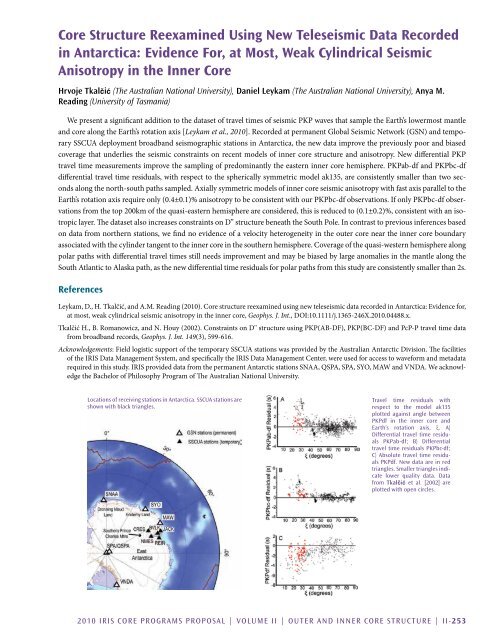Download Volume II Accomplisments (28 Mb pdf). - IRIS
Download Volume II Accomplisments (28 Mb pdf). - IRIS
Download Volume II Accomplisments (28 Mb pdf). - IRIS
Create successful ePaper yourself
Turn your PDF publications into a flip-book with our unique Google optimized e-Paper software.
Core Structure Reexamined Using New Teleseismic Data Recorded<br />
in Antarctica: Evidence For, at Most, Weak Cylindrical Seismic<br />
Anisotropy in the Inner Core<br />
Hrvoje Tkalčić (The Australian National University), Daniel Leykam (The Australian National University), Anya M.<br />
Reading (University of Tasmania)<br />
We present a significant addition to the dataset of travel times of seismic PKP waves that sample the Earth’s lowermost mantle<br />
and core along the Earth’s rotation axis [Leykam et al., 2010]. Recorded at permanent Global Seismic Network (GSN) and temporary<br />
SSCUA deployment broadband seismographic stations in Antarctica, the new data improve the previously poor and biased<br />
coverage that underlies the seismic constraints on recent models of inner core structure and anisotropy. New differential PKP<br />
travel time measurements improve the sampling of predominantly the eastern inner core hemisphere. PKPab-df and PKPbc-df<br />
differential travel time residuals, with respect to the spherically symmetric model ak135, are consistently smaller than two seconds<br />
along the north-south paths sampled. Axially symmetric models of inner core seismic anisotropy with fast axis parallel to the<br />
Earth’s rotation axis require only (0.4±0.1)% anisotropy to be consistent with our PKPbc-df observations. If only PKPbc-df observations<br />
from the top 200km of the quasi-eastern hemisphere are considered, this is reduced to (0.1±0.2)%, consistent with an isotropic<br />
layer. The dataset also increases constraints on D’’ structure beneath the South Pole. In contrast to previous inferences based<br />
on data from northern stations, we find no evidence of a velocity heterogeneity in the outer core near the inner core boundary<br />
associated with the cylinder tangent to the inner core in the southern hemisphere. Coverage of the quasi-western hemisphere along<br />
polar paths with differential travel times still needs improvement and may be biased by large anomalies in the mantle along the<br />
South Atlantic to Alaska path, as the new differential time residuals for polar paths from this study are consistently smaller than 2s.<br />
References<br />
Leykam, D., H. Tkalčić, and A.M. Reading (2010). Core structure reexamined using new teleseismic data recorded in Antarctica: Evidence for,<br />
at most, weak cylindrical seismic anisotropy in the inner core, Geophys. J. Int., DOI:10.1111/j.1365-246X.2010.04488.x.<br />
Tkalčić H., B. Romanowicz, and N. Houy (2002). Constraints on D'' structure using PKP(AB-DF), PKP(BC-DF) and PcP-P travel time data<br />
from broadband records, Geophys. J. Int. 149(3), 599-616.<br />
Acknowledgements: Field logistic support of the temporary SSCUA stations was provided by the Australian Antarctic Division. The facilities<br />
of the <strong>IRIS</strong> Data Management System, and specifically the <strong>IRIS</strong> Data Management Center, were used for access to waveform and metadata<br />
required in this study. <strong>IRIS</strong> provided data from the permanent Antarctic stations SNAA, QSPA, SPA, SYO, MAW and VNDA. We acknowledge<br />
the Bachelor of Philosophy Program of The Australian National University.<br />
Locations of receiving stations in Antarctica. SSCUA stations are<br />
shown with black triangles.<br />
Travel time residuals with<br />
respect to the model ak135<br />
plotted against angle between<br />
PKPdf in the inner core and<br />
Earth’s rotation axis, ξ. A)<br />
Differential travel time residuals<br />
PKPab-df; B) Differential<br />
travel time residuals PKPbc-df;<br />
C) Absolute travel time residuals<br />
PKPdf. New data are in red<br />
triangles. Smaller triangles indicate<br />
lower quality data. Data<br />
from Tkalčić et al. [2002] are<br />
plotted with open circles.<br />
2010 <strong>IRIS</strong> Core Programs Proposal | <strong>Volume</strong> <strong>II</strong> | Outer and Inner Core Structure | <strong>II</strong>-253
















